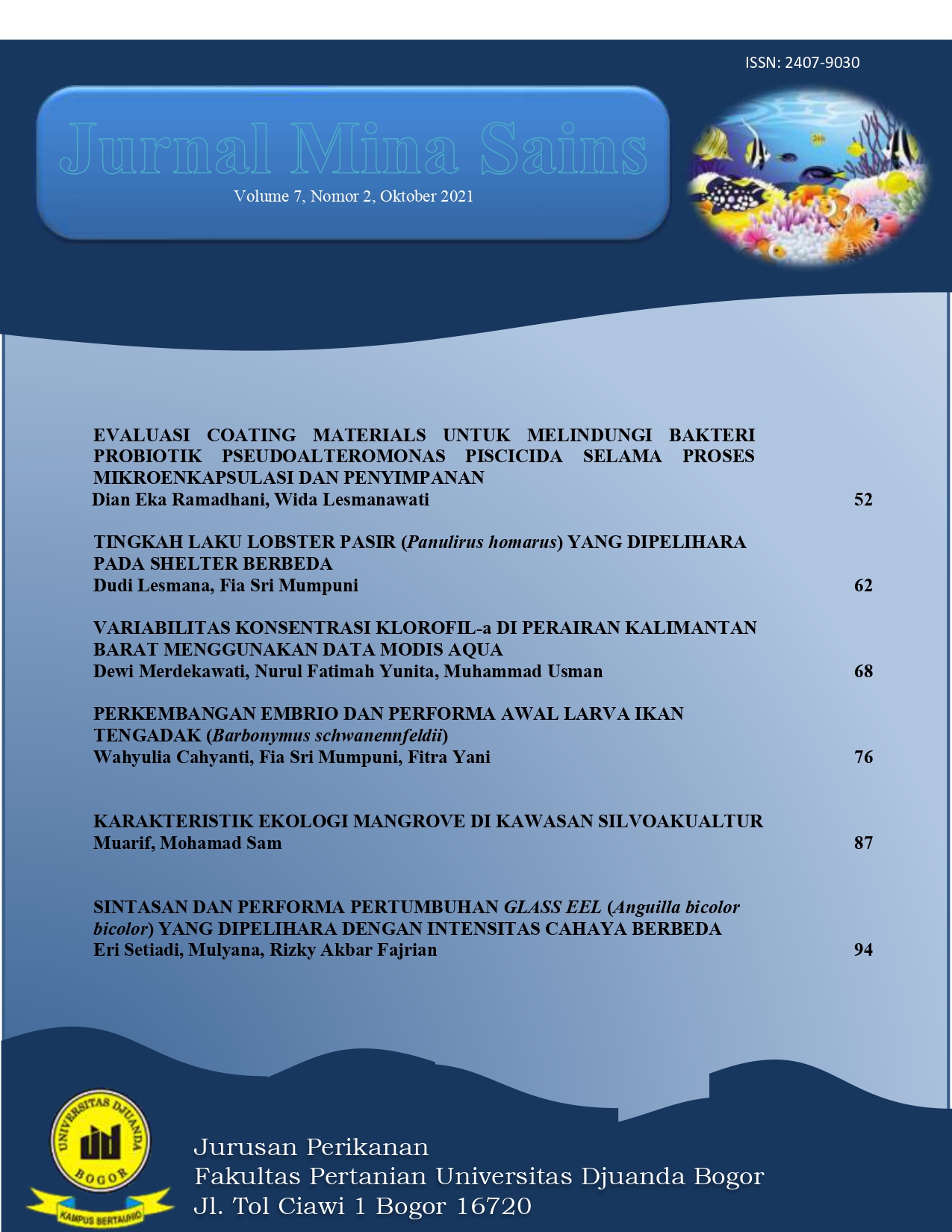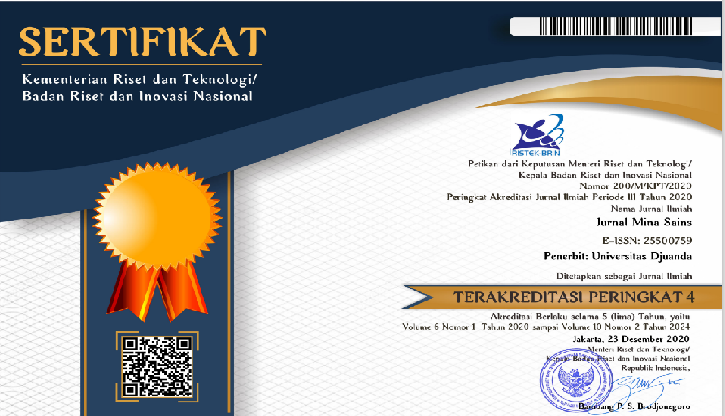SINTASAN DAN PERFORMA PERTUMBUHAN GLASS EEL (Anguilla bicolor bicolor) YANG DIPELIHARA DENGAN INTENSITAS CAHAYA BERBEDA
DOI:
https://doi.org/10.30997/jmss.v7i2.4689Keywords:
Glass eel, Growth, Light intensity, Survival rateAbstract
Typical constraints on eel cultivation are high mortality and slow growth rates. The purpose of this study was to determine the best light intensity for the increase in the survival rate and growth of glass eel (Anguilla bicolor bicolor). This research was conducted at Multi-Species Hatchery (MSH) Environmental Technology Research Installation and Toxicology of Freshwater Aquaculture Cibalagung, Bogor City. The research design used is a Complete RandomIzed Plan (RAL) of four treatments and three replication. Treatment A (250 Lux), treatment B (500 Lux), treatment C (750 Lux), treatment K (Without light intensity). Glass eel is kept for 50 days. The parameters and data analyzed statistically include specific growth rate (SGR), absolute length growth, absolute weight growth and survival rate (SR). The data is analyzed using a variety analysis (ANOVA). If obtained, a significant result (P<0.05) is conducted Duncan multiple range test. In addition, water quality parameters (DO, temperature and pH) are descriptively analyzed. Based on the results of the experiment, light affects the growth of both length and weight. The optimal light intensity for long growth and weight loss, i.e. C (750 Lux) treatment, produces the highest value and differs markedly from the A (250 Lux), B (500 Lux) and K (No light intensity) treatments in absolute weight growth parameters (0.37± 0.01 g), the rate of growth of specific weights (1.76±0.01 % / day), the total length (1.8±0.14 cm) and the specific length growth rate (3.41±0.05 % / day). However, for the highest contention obtained in treatment K (without light intensity) with a value of 66%, the value produced a result that differed markedly from other treatments.
References
Affandi R, Budiardi T, Wahju RI, Taurusman AA. 2013. Pemeliharaan ikan sidat dengan sistem air bersirkulasi. Jurnal Ilmu Pertanian Indo-nesia (JIPI). 18 (1): 55-60.
Boeuf G, Le Bail PY. 1999. Does light have an influence on fish growth. Aquaculture, 177(1-4): 129-152.
Budiharjo A. 2010. Komposisi jenis larva sidat (Anguilla spp.) yang bermigrasi ke muara Sungai Progo, Yogyakarta. Berkala Penelitian Hayati, 15(2): 121-126.
Department of Environment and Heritage Protection (2009) Queensland Water Quality Guidelines, Version 3, ISBN 978-0-9806986-0-2.
Diansyah S, Budiardi T, Sudrajat AO 2014. Kinerja pertumbuhan Anguilla bicolor bobot awal 3 g dengan kepadatan berbeda. Jurnal Akuakultur Indonesia, 13(1): 46-53.
Effendie MI, 1997 Biologi peri-kanan. Yogyakarta: Yayasan Pustaka Nusantara.
Febri PS, Antoni A, Rasuldi R, Sina-ga A, Haser TF, Syahril M, Nazlia S 2020. Adaptasi wak-tu pencahayaan sebagai strategi peningkatan pertum-buhan ikan bawal air tawar (Colossoma macropomum). Acta Aquatica: Aquatic Sci-ences Journal, 7(2): 68-72.
Fekri L, Affandi R, Budiardi T 2014. Tingkat pemberian pakan ikan sidat (Anguilla bicolor bicol-or) ukuran 1–2 g Jurnal Akuakultur Indonesia, 13(1): 21-27.
Haryono, Jojo SG 2011. Kelangsun-gan hidup dan perilaku benih sidat (Anguilla bicolor) pada awal pemeliharaan dengan sa-linitas berbeda. Prosiding Seminar Nasional Ikan 261-266
Kusen KO, Tumbol RA, Manoppo H 2019. Identifikasi Penyakit Bakterial Pada Benih Sidat (Anguilla marmorata) di Balai Budidaya Air Tawar Tatelu. E Journal Budidaya Perairan, 3(1): 68-73.
Muarif, Wahyudin Y, Merdekawati D. 2019. Water quality at sil-voaquaculture pond in in-dramayu regency. IOP Conf. Ser. Earth Environ. Sci. 383(2019):012033.
Nawir F, Utomo NBP, Budiardi T. 2015. Pertumbuhan ikan sidat yang diberi kadar protein dan rasio energi protein pakan berbeda. Jurnal Akuakultur Indonesia, 14(2): 128-134.
Ndobe S. 2010. Struktur ukuran glass eel ikan sidat (Anguilla marmorata) di muara sungai Palu, Kota Palu, Sulawesi Tengah. Media Litbang Sulteng, 3(2): 144-150.
Nurdin M, Nirmala K, Widiyati A. 2015. Kajian perbedaan lama penyinaran dan intensitas ca-haya terhadap pertumbuhan serta sintasan benih ikan ten-gadak (Barbonymus schwanenfeldii). Jurnal Riset Akuakultur, 10(3): 371-378.
Pujautama R, Muarif, Mulyana. 2020. Rasio konversi pakan dan mortalitas ikan bandeng yang dibudidaya pada tam-bak silvoakuakultur. J. Mina Sains. 6(1):17–27.
Rahmawati S. 2015. Pengaruh Padat Tebar Berbeda terhadap Per-tumbuhan dan Kelangsungan Hidup Benih Ikan Sidat di Balai Benih Ikan Kota Gorontalo. Jurnal Ilmiah Perikanan dan kelautan, 3(2): 64-70.
Rahmawati PAA, Hudaidah S, Ma-harani HW. 2016. Pengaruh intensitas cahaya selama pemeliharaan benih ikan kerapu macan (Epinephelus fuscoguttatus). Jurnal Rekayasa Teknologi dan Budidaya Perairan, 5(1): 547-558.
Safitri N. 2015. Pengaruh Tingkat Intensitas Cahaya Terhadap Petumbuhan dan Sintasan Benih Ikan Gabus (Channa striata). [SKRIPSI]. Bogor: Institut Pertanian Bogor.
Samsundari S, Wirawan GA. 2015. Analisis penerapan biofilter dalam sistem resirkulasi ter-hadap mutu kualitas air budi-daya ikan sidat (Anguilla bi-color). Jurnal Gamma, 8(2): 86-97.
Suryono T, Badjoeri M. 2013. Kuali-tas air pada uji pembesaran larva ikan sidat (Anguilla Spp.) dengan sistem pemeli-haraan yang berbeda. Lim-notek: Perairan Darat Tropis di Indonesia, 20(2): 169-167.
Yuda M, Setiawan, Adriani M, Mur-jani A. 2015. Pengaruh foto-periode terhadap aktifitas per-tumbuhan dan kelangsungan hidup ikan patin siam (Pan-gasius hypophthalmus). Fish Scientiae, 5(2): 73-97.
Zonneveld NA, Huisman A, Boon JH. 1991. Prinsip-prinsip Budidaya Ikan. Jakarta: PT Gramedia Pustaka Utama.

Downloads
Published
How to Cite
Issue
Section
License
Copyright (c) 2021 JURNAL MINA SAINS

This work is licensed under a Creative Commons Attribution-NonCommercial-ShareAlike 4.0 International License.
With the receipt of the article by the Jurnal Mina Sains Universitas Djuanda Editorial Board and the decision to be published, then the copyright regarding the article will be diverted to Jurnal Mina Sains Universitas Djuanda.
Department of Fisheries Djuanda University holds the copyright regarding all the published articles in this journal.
Department of Fisheries Faculty of Agriculture, Universitas Djuanda has the right to multiply and distribute the article. Thanks to the Fisheries Department and Agriculture Faculty Universitas Djuanda that funded this journal sustainability.
The manuscript's authentic and copyright statement submission can be downloaded on this form.








